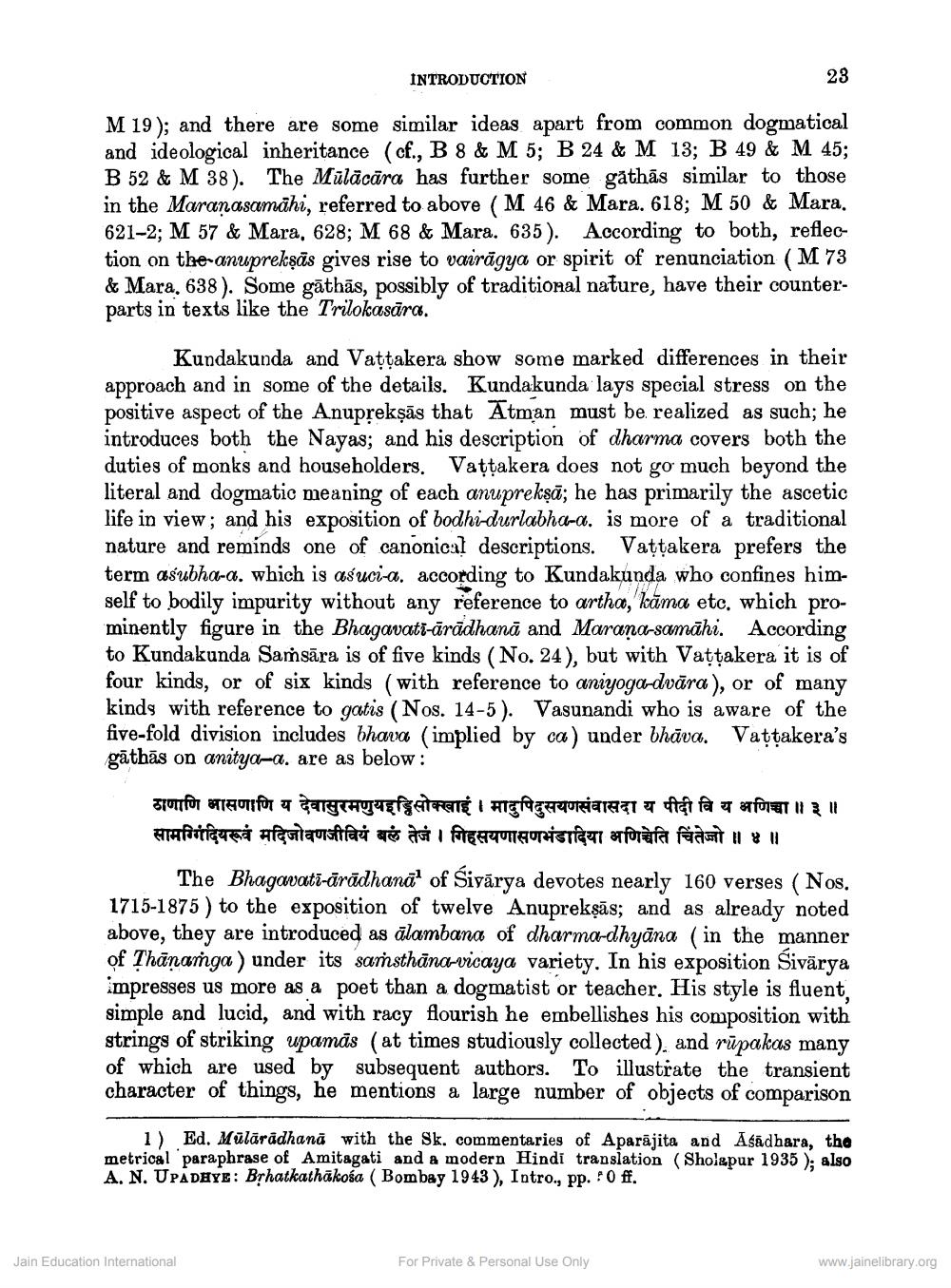________________
INTRODUCTION
23
M 19); and there are some similar ideas apart from common dogmatical and ideological inheritance (cf., B 8 & M 5; B 24 & M 13; B 49 & M 45; B 52 & M 38). The Mülācāra has further some gathās similar to those in the Maranasamāhi, referred to above (M 46 & Mara. 618; M 50 & Mara. 621-2; M 57 & Mara, 628; M 68 & Mara. 635). According to both, reflection on the-anupreksäs gives rise to vairāgya or spirit of renunciation (M 73 & Mara, 638). Some gāthās, possibly of traditional nature, have their counterparts in texts like the Trilokasāra.
Kundakunda and Vattakera show some marked differences in their approach and in some of the details. Kundakunda lays special stress on the positive aspect of the Anuprekşās that Atman must be realized as such; he introduces both the Nayas; and his description of dharma covers both the duties of monks and householders. Vattakera does not go much beyond the literal and dogmatic meaning of each anupreksā; he has primarily the ascetic life in view; and his exposition of bodhi-durlabha-a. is more of a traditional nature and reminds one of canonical descriptions. Vattakera prefers the term aśubha-a. which is asuci-a. according to Kundakunda who confines himself to bodily impurity without any reference to artha, kāma etc. which prominently figure in the Bhagavati-ārādhanā and Marana-samāhi. According to Kundakunda Samsāra is of five kinds (No. 24), but with Vattakera it is of four kinds, or of six kinds (with reference to aniyoga-dvāra), or of many kinds with reference to gatis (Nos. 14-5). Vasunandi who is aware of the five-fold division includes bhava (implied by ca) under bhāva. Vattakera's gāthās on anitya-a. are as below:
ठाणाणि भासणाणि य देवासुरमणुयइड्डिसोक्खाई। मादुपिदुसयणसंवासदा य पीदी वि य अणिचा ॥३॥ सामग्गिदियरूवं मदिजोवणजीवियं बलं तेज । गिहसयणासणभंडादिया अणिञ्चेति चिंतेज्जो ॥४॥
The Bhagavatī-ārādhana' of Sivārya devotes nearly 160 verses ( Nos. 1715-1875 ) to the exposition of twelve Anupreksās; and as already noted above, they are introduced as ālambana of dharma-dhyāna (in the manner of Thānanga ) under its saṁsthāna-vicaya variety. In his exposition Sivärya impresses us more as a poet than a dogmatist or teacher. His style is fluent. simple and lucid, and with racy flourish he embellishes his composition with strings of striking upamās (at times studiously collected), and rūpakas many of which are used by subsequent authors. To illustrate the transient character of things, he mentions a large number of objects of comparison
1) Ed. Mülārādhanã with the Sk. commentaries of Aparājita and Asādhara, the metrical paraphrase of Amitagati and a modern Hindi translation (Sholapur 1935 ), also A. N. UPADHYE: Brhatkathākośa (Bombay 1943), Intro., pp. : 0 ff.
Jain Education International
For Private & Personal Use Only
www.jainelibrary.org




